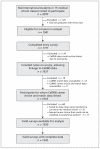Determinants of choosing a career in family medicine
- PMID: 20974721
- PMCID: PMC3017271
- DOI: 10.1503/cmaj.091805
Determinants of choosing a career in family medicine
Abstract
Background: Student choice is an important determinant of the distribution of specialties of practising physicians in many countries. Understanding characteristics at entry into medical school that are associated with the choice of residency in family medicine can assist medical schools in admitting an appropriate mix of students to serve the health care needs of their regions.
Methods: From 2002 to 2004, we collected data from students in 15 classes at 8 of 16 Canadian medical schools at entry. Surveys included questions on career choice, attitudes to practice and socio-demographic characteristics. We followed students prospectively with these data linked to their residency choice. We used multiple logistic regression analysis to identify entry characteristics that predicted a student's ultimate career choice in family medicine.
Results: Of 1941 eligible students in the participating classes, 1542 (79.4%) contributed data to the final analyses. The following 11 entry variables predicted whether a student named family medicine as his or her top residency choice: being older, being engaged or in a long-term relationship, not having parents with postgraduate university education nor having family or close friends practicing medicine, having undertaken voluntary work in a developing nation, not volunteering with elderly people, desire for varied scope of practice, a societal orientation, a lower interest in research, desire for short postgraduate training, and lower preference for medical versus social problems.
Interpretation: Demographic and attitudinal characteristics at entry into medical school predicted whether students chose a career in family medicine.
Figures
Comment in
-
Don't select medical students--convince them.CMAJ. 2011 Nov 22;183(17):2017. doi: 10.1503/cmaj.111-2084. CMAJ. 2011. PMID: 22106108 Free PMC article. No abstract available.
References
-
- Chan B. From perceived surplus to perceived shortage: What happened to Canada’s physician workforce in the 1990s? Ottawa (ON): Canadian Institute for Health Information; 2002. Available: http://secure.cihi.ca/cihiweb/products/chanjun02.pdf (accessed 2010 Apr. 20).
-
- Cooper RA. Weighing the evidence for expanding physician supply. Ann Intern Med 2004;141:705–14 - PubMed
-
- Jeon S, Hurley J. The relationship between physician hours of work, service volume and service intensity. Can Public Policy 2007;33:S17–S30
-
- Watson DE, Slade S, Buske L, et al. Intergenerational differences in workloads among primary care physicians: a ten-year, population-based study. Health Aff (Millwood) 2006;25:1620–8 - PubMed
-
- Lambert TW, Goldacre MJ, Turner G. Career choices of United Kingdom medical graduates of 2002: questionnaire survey. Med Educ 2006;40:514–21 - PubMed
Publication types
MeSH terms
LinkOut - more resources
Full Text Sources

